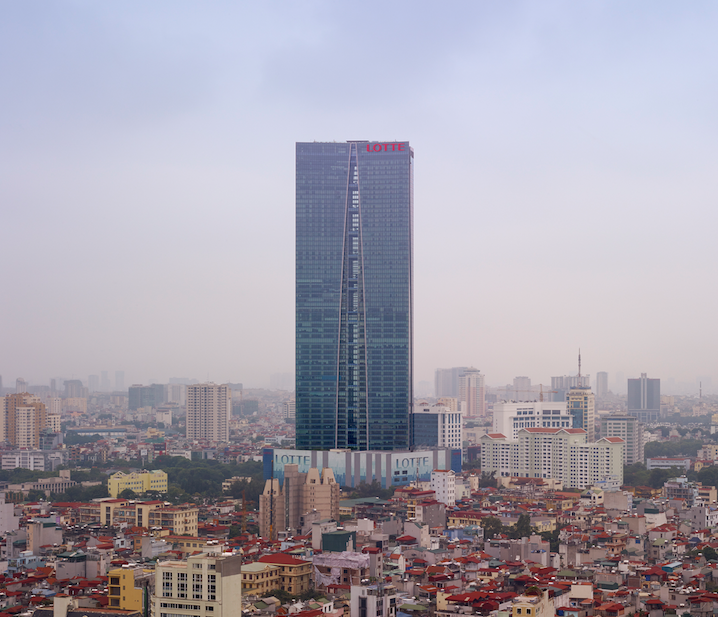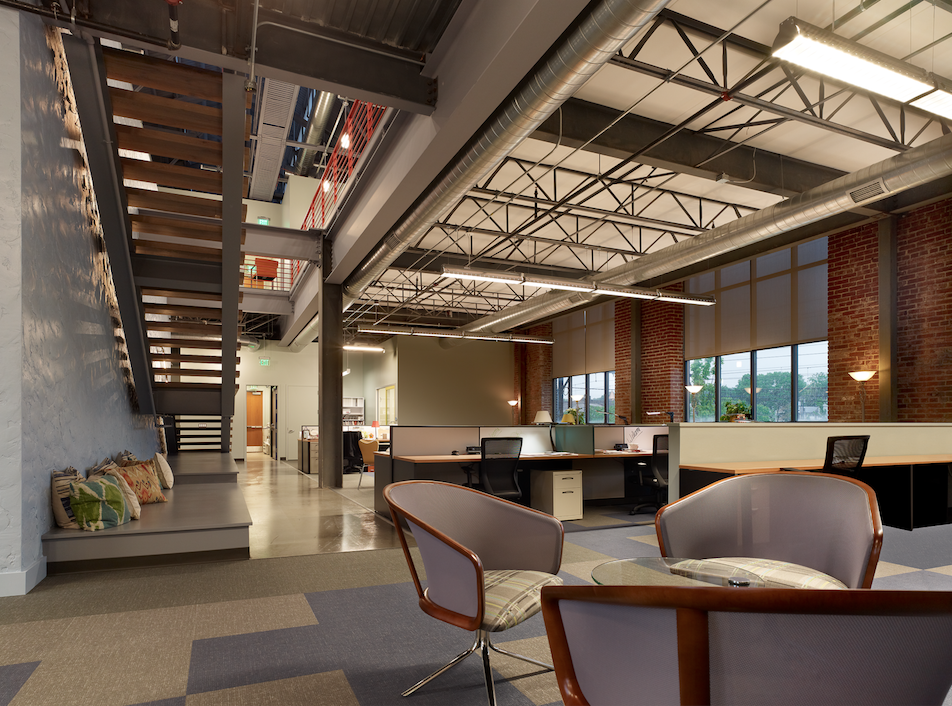Office developers are never shy about calling out the special features of their properties. But it’s still somewhat rare for them to crow about energy efficiency and sustainability as selling points.
Take Hudson Pacific Properties, which broke ground on ICON, a 323,000-sf office tower in Hollywood, Calif., in June. The 14-story, $200 million project, designed by Gensler and being constructed by McCarthy Building Companies, stacks five rectangular volumes offset horizontally to create the optimum number of terraces. Hudson Pacific extolled its 25,000-sf floor plates and 45-foot column-free spans, but neglected to mention the development’s high-performance envelope, which alternates between glass curtain wall and precast panels.
Liberty Property Trust and Synterra Partners were equally circumspect about their 94,000-sf office building, 1200 Intrepid, which got rolling at Philadelphia’s Navy Yard in July. You had to go to the website of the designer, Bjarke Ingels Group, to learn that the tower is pursuing LEED Gold certification.
It’s not that developers don’t see the value of energy-saving, high-performance workplaces as marketing tools. But some developers are missing an opportunity by downplaying sustainability at a time when demand for such features is palpable among lessee firms who are trying to attract younger workers.
Scott Davis, PE, LEED AP, Director of Mechanical Engineering for Bala Consulting Engineers, says that “energy codes are dictating” energy-saving and sustainable measures. Daniel Tisak, DBA, LEED AP, CSDP, CBCP, EBCP, Bala’s Director of Validation and Commissioning, adds that such features as green roofs, energy-recovery wheels, solar shading, LED lighting, and PV arrays “are now commonly found, or at least considered, for office building projects.”
Four factors affect how offices get built these days, says Matthias Olt, Callison’s Director of Sustainable Design: legislation, cost, public awareness, and sustainable design. Olt notes that over the past year or so, he’s seen a slowdown in demand for buildings pursuing LEED certification, but “there’s been no slowdown in the quest for high-performance buildings.” Olt recalls a recent conversation with a tower owner in New York City who wants to install a full solar-panel array on all four sides of his building.
 The 65-story Lotte Center Hanoi in Vietnam treats its sewage on site through a membrane bioreactor filtering system. The Building Team: Callison (design), Doul International (AOR/MEP), and Turner Construction (GC). Photo: CallisonRTKL
The 65-story Lotte Center Hanoi in Vietnam treats its sewage on site through a membrane bioreactor filtering system. The Building Team: Callison (design), Doul International (AOR/MEP), and Turner Construction (GC). Photo: CallisonRTKL
As for sustainable design, Olt singles out Callison’s Lotte Center Hanoi. The 272-meter high-rise, in Vietnam’s capital, features five stories of central sky garden atria that climb along the tower’s spine. An on-site sewage treatment system can filter so-called “black” water to near drinking-water quality. Sludge collected in the basement is shipped off-site to make fertilizer.
Davis points out that many of Bala’s office clients use LEED as a guideline, but are more focused on sustainability. Still, one of Bala’s most highly touted recent office projects is its renovation of the Ambler (Pa.) Boiler House into 48,000 sf of Class A, LEED Gold office space. The project included the installation of geothermal heat pumps with 53 wells and a graywater recycling system.
Another high-performance Bala project: GlaxoSmithKline’s four-story, 85,000-sf corporate headquarters—the first double LEED Platinum building (for Core + Shell and Commercial Interiors) in Philadelphia. It features latent heat recovery, outside air preconditioning, light controls and sun shading, and an HVAC system that uses floor-to-floor water-cooled units configured to deliver low-temperature dehumidified air to occupied spaces.
wHow water is used (and reused) in office projects should always be up for discussion, says Kirill Pivovarov, AIA, LEED AP, Senior Associate, RTKL, Washington, D.C. His firm recently won a high-stakes competition for a 1.3-million-sf office complex in a coastal area near Shanghai, China. But designing office buildings to achieve near-net-zero consumption is a stretch, says Pivovarov, because it takes a gallon of water to produce one kilowatt of off-site energy.
In its design for this complex, RTKL took into account how water would be used. “This made on-site energy generation so much more important,” he explains. A water storage and special filtration systems facility will be built on site. Pivovarov estimates this building should be able to achieve 70% net-zero water use.
Water-based systems, such as chilled beams, are among the recommendations Bala makes to owners and developers seeking efficiencies, says Davis. He also sees opportunities in retro-commissioning existing buildings, especially for companies that are consolidating their workforces and using less office space over time.
Tisak adds that Building Teams should look closely at the project’s lighting. “We reduced lighting energy consumption by over 40% simply through a careful selection of energy-wise bulbs and fixtures,” he says.
Callison’s Olt thinks more could be done to reduce an office’s energy footprint. “How high-performing is the skin? Will envelope systems like triple-glazed windows be acceptable? Can you install liquid thermal control systems? What about air-movement, air-supply, and energy storage systems?” he asks.
Olt also wonders about the role sustainable timber might ultimately play in high-rise office construction. “Vienna has built a high-rise with wood, and Finland has one in the works,” he says. “We’re talking to Seattle about this.”
In late July, the developer Hines broke ground in Minneapolis’s North Loop neighborhood near Target Field on a 220,000-sf, seven-story office building designed by DLR Group and Michael Green Architecture—the first such commercial property in the U.S. to use engineered wood for its structure and interior. Steve Luthman, Hines’s Senior Director, told the Star Tribune that the 100,000 cubic feet of wood used for the interior is regenerated by forests in North America every eight minutes.
Related Stories
Office Buildings | Mar 27, 2024
A new Singapore office campus inaugurates the Jurong Innovation District, a business park located in a tropical rainforest
Surbana Jurong, an urban, infrastructure and managed services consulting firm, recently opened its new headquarters in Singapore. Surbana Jurong Campus inaugurates the Jurong Innovation District, a business park set in a tropical rainforest.
Adaptive Reuse | Mar 26, 2024
Adaptive Reuse Scorecard released to help developers assess project viability
Lamar Johnson Collaborative announced the debut of the firm’s Adaptive Reuse Scorecard, a proprietary methodology to quickly analyze the viability of converting buildings to other uses.
Sustainability | Mar 21, 2024
World’s first TRUE-certified building project completed in California
GENESIS Marina, an expansive laboratory and office campus in Brisbane, Calif., is the world’s first Total Resource Use and Efficiency (TRUE)-certified construction endeavor. The certification recognizes projects that achieve outstanding levels of resource efficiency through waste reduction, reuse, and recycling practices.
Office Buildings | Mar 21, 2024
Corporate carbon reduction pledges will have big impact on office market
Corporate carbon reduction commitments will have a significant impact on office leasing over the next few years. Businesses that have pledged to reduce their organization’s impact on climate change must ensure their next lease allows them to show material progress on their goals, according to a report by JLL.
Adaptive Reuse | Mar 21, 2024
Massachusetts launches program to spur office-to-residential conversions statewide
Massachusetts Gov. Maura Healey recently launched a program to help cities across the state identify underused office buildings that are best suited for residential conversions.
Office Buildings | Mar 21, 2024
BOMA updates floor measurement standard for office buildings
The Building Owners and Managers Association (BOMA) International has released its latest floor measurement standard for office buildings, BOMA 2024 for Office Buildings – ANSI/BOMA Z65.1-2024.
Sustainability | Mar 13, 2024
Trends to watch shaping the future of ESG
Gensler’s Climate Action & Sustainability Services Leaders Anthony Brower, Juliette Morgan, and Kirsten Ritchie discuss trends shaping the future of environmental, social, and governance (ESG).
Office Buildings | Mar 8, 2024
Conference room design for the hybrid era
Sam Griesgraber, Senior Interior Designer, BWBR, shares considerations for conference room design in the era of hybrid work.
Office Buildings | Mar 5, 2024
Former McDonald’s headquarters transformed into modern office building for Ace Hardware
In Oak Brook, Ill., about 15 miles west of downtown Chicago, McDonald’s former corporate headquarters has been transformed into a modern office building for its new tenant, Ace Hardware. Now for the first time, Ace Hardware can bring 1,700 employees from three facilities under one roof.
Designers | Feb 23, 2024
Coverings releases top 2024 tile trends
In celebration of National Tile Day, Coverings, North America's leading tile and stone exhibition, has announced the top 10 tile trends for 2024.

















